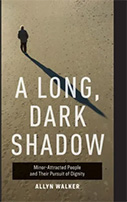A Long, Dark Shadow: Minor-Attracted People and Their Pursuit of Dignity

Author: Allyn Walker
Publisher: University of California Press, 2021. 236 pages.
Reviewer: Michael P. Lasher | September 2022
Anglo-centric society has a complicated relationship with sex. Sex is often criticized in public while being exalted behind closed doors. Those who do not sexually “fit in” have, until recently, been relegated to the margins of society out of public discourse. Although many sexual subjects, such as homosexuality, polyamory, and BDSM (sex involving dominance, submission and control), have been somewhat normalized in wider discussions and popular culture, there is one topic which continues to receive wide-spread segregation: sexual attraction to minors. While the focus on minor-attracted persons (MAPs) often concerns sexual offenders, Allyn Walker (they/them) attempts to tackle the stigma faced by non-offending MAPs by drawing heavily from their own qualitative research in the book A Long, Dark Shadow: Minor-Attracted People and Their Pursuit of Dignity. Walker defines the goal of the book as exploring “ways of thinking about MAPs that better protect children from harm,” and approaches this by describing the experiences of interviewed MAPs across five domains: forming an identity as a minor-attracted person, choosing to disclose an attraction to children, strategies for coping with sexual attraction to children, and experiences seeking help and working with mental health providers in general.
In the first chapter, Walker discusses how their research participants developed an awareness of sexual attraction to minors. From the beginning of the book, the research participants’ own words are included to describe their experiences. This serves to humanize these individuals, a characteristic that persists through the book, in light of discussing the challenging subject matter. Walker establishes some concepts associated with minor-attraction that might be unfamiliar to a reader new to the concept of minor-attraction, such as age of attraction (the component of sexual interest concerning to what ages an individual is specifically aroused). Beyond humanizing their research participants, Walker does this to further establish that minor-attracted individuals do not fit a specific mold: because one is attracted to individuals younger than the age of consent does not mean that he or she is attracted to all children. Walker also discusses how their research participants coped with the identity of “pedophile.” Walker uses this to parallel the experience with identity formation as a minor-attracted person with that of individuals in the LGBTQ community. Specifically, Walker attempts to fit their research participants’ experiences with Troiden’s identity formation model: sensitization, identity confusion, identity assumption, and commitment. Again, Walker’s approach serves to humanize the experience of minor-attracted persons.
While chapter one focuses on the intrinsic experience of understanding one’s attraction to minors, chapter two discusses the challenges of whether or not to be open about their sexual interest. Walker again parallels the experience of their research participants with individuals in the LGBTQ community utilizing the concepts of “being in the closet” and “coming out.” Again, Walker humanizes their research participants by using first-hand accounts of disclosing sexual attraction to minors. This includes how some individuals disclose as a “last resort,” as part of a plea for help in the midst of suicidal ideation, and how it is challenging to face the stigma of pedophilic disorder, expectations of impulsivity, and fear of vigilante threats. These fears are also discussed by Walker early in this chapter by addressing problems faced in counseling, specifically concerning the lack of training mental health providers have with this topic, and problems with some treatment providers engaging in “sexual orientation change efforts” (SOCE), more colloquially referred to as conversion therapy.
Problems with seeking help are expanded on later in the book (chapter five). Walker predominantly identifies the themes among treatment providers being related to either of being driven by assumptions, rigidity, misinformation, and/or poor training. Chapter five covers a wide range of issues faced by minor attracted individuals, however it is hard not to focus on the indictment of mental health providers when the chapter is titled “Their Intention Wasn’t to Help Me.” Again, this is drawing on the interviews Walker conducted, and it is acknowledged that treatment providers have ethical and legal obligations regarding reporting requirements. On the other hand, Walker is quick to criticize the use of SOCE in therapy, but does not give a clear explanation of how often this form of therapy is employed. Unfortunately, the discussion of how research participants described coming to be involved in mental health treatment feels lost in the middle of this chapter.
In the midst of these discussions about the challenges brought about by ill-informed mental health providers, Walker addresses how their research participants coped with both their developing identities as a minor-attracted person and the reasons why they do not act on their sexual interests. Chapters three and four are perhaps the most compelling of the entire book. Chapter three addresses how these individuals coped with the realization that they have a sexual interest rejected by society at large. Walker’s research participants described the balance between avoidance strategies, from denial to drug use, as well as how many of these individuals found support from other non-offending minor-attracted individuals. In that same line, chapter four describes the various strategies Walker’s research participants identified to remain abstinent from abusive sexual behavior. First and foremost being not wanting to cause harm. Walker describes how many described not having urges, and paralleled the experiences of many minor-attracted individuals to that of adult-attracted persons not all acting on sexual impulses or even struggling with such impulses. Fear of punishment was also identified as a reason to not sexually offend, as well as religious beliefs, concerns about how such sexual acts can impact the families of victims, and bringing shame to their own families.
In considering a critique of A Long, Dark Shadow, let us begin with the challenges of qualitative research. Walker has taken a considerable body of interview data and condensed it down into what has become the bulk of their book. The clear strength of this book is that it gives voice to a highly marginalized community. If, in 2021, you were to search “minor attracted person” on YouTube, the majority of search results would feature people challenging the acceptance of minor attracted people without a clear differentiation between those who chose to sexually offend against children and those who actively abstain from sexually abusive behavior. Indeed, it is often a theme in popular discourse that sexual attraction to minors and child sexual abuse are fatally entangled. Walker makes it clear in their book that child sexual abuse is unacceptable, and emphasizes that affirmatively supporting individuals who are attracted to minors to not act out on unhealthy sexual impulses is a more effective prevention approach than shaming them into societal compliance. To that end, Walker offers some suggestions to help, such as improving professionals understanding of the dynamics of minor-attracted persons and mandatory reporting requirements, educating professionals about the drawbacks of conversion therapy, and working towards a broad shift in social attitudes towards minor-attracted people.
Unfortunately, Walker chooses to focus on their own research almost exclusively, barely putting their work into any larger context. For example, if the reader is not familiar with the last 30 to 40 years of the active normalization efforts by some within the minor attracted community, it might seem like a small (even trivial) point that Walker cautiously treads on the parallels between the minor-attracted community and the LGBTQ community. However, an awareness of how factions within the minor-attracted community were previously notorious for attempting to normalize adult-child sexual activity in part by aligning with what is now the LGBTQ community (and ultimately resulting in a scantily reported conflict between each group) would provide the reader with a greater context for how stigma has been bolstered both by broad population fears as well as by the actual efforts of some bad actors within the minor-attracted community. On the other hand, there is little discussion of the extant efforts being made to support the non-offending minor-attracted community, such as the Help Wanted Project of Johns Hopkins University or Germany’s Prevention Project Dunkelfeld.
One major, unavoidable question when doing a critical reading of this book is, who is the intended audience? Walker is highly critical of mental health professionals, but this book does not provide a significant guide to mental health professionals on how to best work with this population. Granted, there are some recommendations for treatment providers as noted above; however, this is far from a comprehensive compilation of treatment strategies. For those healthcare professionals who are already familiar with the topics discussed in the book, little is likely added to their knowledge about this topic beyond more detailed first-person stories. For those professionals who are either not familiar or not comfortable with this topic, it is hard to predict how much this will inspire a change in attitudes towards the minor-attracted community. At best, this might be a primer for the uninitiated: for students learning about working with a community treatment population or special needs clinic; for invested community parties without a strong understanding of pedophilic disorder outside of the stereotypic discourse; for family members learning to cope with someone’s personal disclosure; or for a minor-attracted person him-or-herself who is looking to better understand and cope with his or her building realization that he or she is not like “everyone else.”
While A Long Dark Shadow has its limitations, it is nonetheless a worthwhile addition to the growing literature on individuals who are sexually attracted to minors, but who abstain from sexually abusive behavior. Walker is arguably correct that supporting individuals who are motivated to not engage in abusive behavior may do more to prevent child sexual abuse than driving these people into hiding; how this societal paradigm shift is to be achieved is not easily answered though. Until the public at large is willing to have a more objective discussion of this issue, it will take efforts such as what Walker has presented to attempt to educate interested parties that supporting, not shunning, these people is still an option.
Michael P. Lasher, PhD is a Licensed Clinical Psychologist and Certified Sex Offender Treatment Provider at the Virginia Department of Corrections


